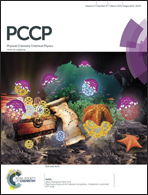Promoting the “water-wire” mechanism of double proton transfer in [2,2′-bipyridyl]-3,3′-diol by porous gold nanoparticles
Abstract
The effect of nanopores in porous gold nanoparticles (Au NPs) on excited-state double proton transfer (DPT) in [2,2′-bipyridyl]-3,3′-diol (BP(OH)2) in an aqueous environment is the main focus of the present work. DPT in BP(OH)2 is known to take place through two mechanisms. In a bulk environment, an open solvated molecule facilitates the process and emits at 460 nm whereas, in a confined situation, formation of a “water wire” between the prototropic centers leads to the transfer of protons. It has been shown spectroscopically in the present study that in the nanovessels provided by nanoporous Au NPs, the unconventional mechanism of DPT through the formation of a “water wire” is promoted due to the presence of a limited number of water molecules around the probe. Experiments in the presence of solid pure Au, Ag and Au/Ag NPs were performed to support our proposition. Time-resolved fluorescence spectral changes confirm our findings.
![Graphical abstract: Promoting the “water-wire” mechanism of double proton transfer in [2,2′-bipyridyl]-3,3′-diol by porous gold nanoparticles](/en/Image/Get?imageInfo.ImageType=GA&imageInfo.ImageIdentifier.ManuscriptID=C4CP03968H&imageInfo.ImageIdentifier.Year=2015)

 Please wait while we load your content...
Please wait while we load your content...